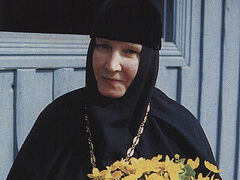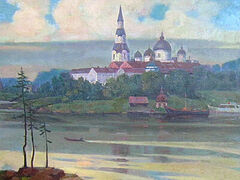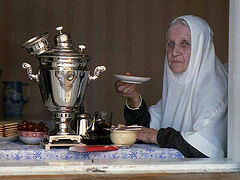Mother Georgia (Shchukina), the honorary Abbess of Gorny Convent, has talked about her life, service and involvement in the revival of convents in Russia and the Holy Land. One of Abbess Georgia’s stories about Gorny Convent is very edifying now, during the Covid epoch.
Our beloved Patriarch
 Jerusalem, 1997, the 150th anniversary of the Russian Ecclesiastical Mission in Jerusalem. Patriarch Alexei II, Chief of the Russian Mission in Jerusalem Archimandrite Theodosius (Vasnev), Abbesses Philareta (Smirnova) and Georgia (Shchukina) —Mother Georgia, you have already told us about two Patriarchs. Did you also know His Holiness Alexei II before his enthronement?
Jerusalem, 1997, the 150th anniversary of the Russian Ecclesiastical Mission in Jerusalem. Patriarch Alexei II, Chief of the Russian Mission in Jerusalem Archimandrite Theodosius (Vasnev), Abbesses Philareta (Smirnova) and Georgia (Shchukina) —Mother Georgia, you have already told us about two Patriarchs. Did you also know His Holiness Alexei II before his enthronement?
—I remember His Holiness from the time he was a student at the Leningrad Theological Seminary. On Wednesdays I went there to read the Akathist hymn in front of the wonderworking Icon of the Mother of God “Of the “Sign”. Alyosha1 Ridiger—tall, slender and thin—always stood on the right choir and read. He learned to sing, although he didn’t have a musical ear then.
After I had joined Pyukhtitsa Convent, he would come to us, sometimes for a few days, with his parents. His father, Priest Michael, and his mother Elena were very spiritual people. When Alyosha Ridiger graduated from the seminary, he was given the first parish in Jõhvi, which is thirteen miles from Pyukhtitsa. We travelled to him. And when he began to pastor St. Nicholas parish in Jaama, he would come to see us. Later he was transferred to Tartu, and then Patriarch Alexei I summoned him for a conversation. After the meeting he immediately invited him to work at the Patriarchate in Moscow.
—Did you keep in touch with him after his transfer?
—Yes, I remember him in early 1968 coming to see us in Vilnius. He already served as Metropolitan of Tallin and Estonia at that time. Even after he had been elected Patriarch, we maintained informal relations and called him, “Sviateishenka” [an affectionate form of the word, “Sviateishi”—Your Holiness. Once he paid a visit to the Holy Spirit Monastery to venerate the relics of the martyrs of Vilnius. Then he learned that the convent in Vilnius had been closed. There he talked with Abbess Nina and then wished to speak with Nun Barbara and me. We asked him many questions about Pyukhtitsa Convent, and he asked us about the obediences we carried out there. Three days later Abbess Nina got a phone call and a telegram from the diocese telling her that Nun Barbara must go to Moscow urgently. Nun Barbara went to Moscow and called me from there, saying that the diocese wanted to send her either to Jerusalem or to Pyukhtitsa.
 Nun Georgia (Shchukina) Before all those events, Abbess Nina had seen crosses all the time—now in reality, now in a dream. She was too weak to get up and only rang a bell. When Nun Barbara came to the abbess and said that they wanted to send her to Jerusalem, the abbess suddenly said again, “I saw a cross again! What a cross it was!” She showed with her hand in the air where she had seen it and explained, “I won’t survive this cross...”
Nun Georgia (Shchukina) Before all those events, Abbess Nina had seen crosses all the time—now in reality, now in a dream. She was too weak to get up and only rang a bell. When Nun Barbara came to the abbess and said that they wanted to send her to Jerusalem, the abbess suddenly said again, “I saw a cross again! What a cross it was!” She showed with her hand in the air where she had seen it and explained, “I won’t survive this cross...”
Then Nun Barbara was again summoned to Moscow, as she had refused to go to Jerusalem. In the end they sent her to Pyukhtitsa. So Vladyka Alexei saved the convent from closure. There he handed the staff to Nun Barbara, and for forty-two years she was the permanent abbess there.
A month later Abbess Nina died. It became clear what kind of cross she had spoken about. Abbess Barbara went to bury her.
—Was St. John’s Convent on the bank of the River Karpovka in St. Petersburg revived on the future Alexei II’s initiative?
—It was in the summer of 1988: Abbess Barbara and I arrived in Moscow for the celebration of the millennium of the Baptism of Russia. Vladyka Alexei suddenly invited us to dinner and asked, “Do you want to have a dependency of Pyukhtitsa Convent?” We were speechless… Then he took out keys and put them on the table, “Mothers, here is the dependency of Pyukhtitsa! On the bank of the Karpovka—the convent founded by Father John of Kronstadt.”
Then it was even scary to talk about Fr. John. Believers walked stealthily past the convent, making the sign of the cross secretly by the window where a cross had already been hollowed out. And now we heard that the whole convent would be returned to the Church! “Mothers, try your best,” he said. “Please restore the church by November 1, the feast of St. John of Ryla.” Fr. John of Kronstadt was named after St. John of Ryla. The Synod had already made the decision, and the State had already agreed to the transfer—through the efforts of the future Alexei II, as he had such power of persuasion! On the same evening we left for St. Petersburg, and there we hurried to St. John’s Convent...
How Fr. John of Kronstadt paid for crosses
—What happened to the convent under the Soviet regime?
—When Abbess Barbara and I arrived at the convent, there were only homeless people living on its territory. All around were stench, filth, rats, overflowing toilets, bottles and cigarette butts—the abomination of desolation. The windows had been shattered. Birds flew inside the church. Where Fr. John’s tomb is located there was a DOSAAF2 school. We removed over fifty gas masks; broken desks and benches, debris and all kinds of rubbish were everywhere. There was so much trash and dirt that it was impossible to enter... But with the help of the sisters we cleared up the mess. The Church of St. John of Ryla was restored in two weeks, by November! A temporary iconostasis was even painted for us during that period!
There was the following story of St. John’s tomb: A cross was hollowed out on a wall outside; and inside, near the same place, we laid a rug, put an icon lamp with fresh flowers and a photo of Fr. John in a frame—he hadn’t yet been canonized. We believed his relics lay there. But when we carried everything away and removed the boards from the dirty floor, we suddenly saw an area encased in concrete...
 Abbess Georgia at St. John of Kronstadt’s burial site in St. John’s Convent of St. Petersburg
Abbess Georgia at St. John of Kronstadt’s burial site in St. John’s Convent of St. Petersburg
—Why was it encased in concrete?
—This was only revealed later. After the Revolution, when the convent was destroyed and many sisters were arrested and exiled, a special commission was set up—they were going to desecrate Fr. John’s holy relics. Polina Vasilievna Malinovskaya told us about that. She lived opposite St. John’s Convent. About five years before the re-opening of the church as a dependency of Pyukhtitsa Convent she visited our convent. She was already very old. Abbess Barbara and I received her. She worried that she was going to die and she needed to “reveal an important secret.” She asked us “not to betray her”—this is how people were afraid to mention the very name of Fr. John! She told us that a close acquaintance of hers was a member of that commission. When they went down to the vault to open the tomb, one of the blasphemers instantly fell dead, and another one went insane on the spot. Then everything was encased in concrete, closed and left.
—I can’t help but add: And they never came back!...
—I told this to His Holiness. A few days after they had found Fr. John’s real burial site, he arrived in St. Petersburg, went down to the vault and was very surprised that the grave was not where the cross was hollowed out from outside... Now a new shrine stands there.
—Did you have any obvious evidence of Fr. John’s help while you served there?
—I certainly did! Once he helped very clearly... After his canonization we began to restore the Cathedral of the Twelve Apostles, which is on the third story of the convent. We also removed plenty of rubbish from there, by the truckload! It had to be re-roofed, as the roof was leaking. And we needed to cover the domes with copper. I ordered crosses. We had the first, second…, fourth cross gilded… But once the workers began to lift them up, they told me, “It’s time to pay up...” I begged them to wait, as I didn’t have the necessary amount. I immediately gave them any funds I received. But now they were demanding money again. Every now and then I began to go to St. John’s tomb and pray, “Send me money! Help me!” And suddenly a man came from Rostov-on-Don, handed me an envelope—and there was exactly as much money as I owed the workers! What a miracle it was!
 St. John’s room in the convent on the bank of the Karpovka
St. John’s room in the convent on the bank of the Karpovka
—Those who restore churches and monasteries constantly talk about such miracles. Thank God!
—And when we began to restore the room of dear Fr. John (where the saint lived), His Holiness was overwhelmed with joy! The convent was being revived, liturgical life resumed and was well established—he was simply jubilant! One evening he called me and asked, “How are things going?” “Your Holiness, Fr. John’s room is almost ready,” I reported. “The parquet floor has been laid and varnished... The cornices and curtains have been hung... Now we are ready to meet you in Fr. John’s room.” “May the Lord bless you, Mother Georgia, for your labors here,” he said sedately in his velvet voice. “And now you should serve in Jerusalem—at Gorny Convent.”
The receiver nearly fell out of my hands...



